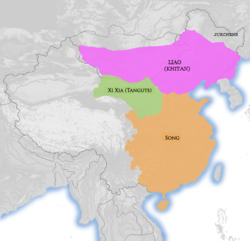The Western Xia (西夏 Xī Xià in Chinese), also known as the Tangut Empire, was an ancient empire in what is now western China.
Understand
[edit]
The Western Xia existed as an empire from 1038 to 1227 in what is today north western China, in the provinces that are now Ningxia and Gansu.
Their empire was the first region outside Mongolia conquered by the Mongol Empire, and they became Mongol vassals. However when the Khan asked for troops for his military campaign against the Khwarezmia in the Middle East, they did not send any. Infuriated, the Khan completely destroyed the Tangut; the destruction was violent and absolute, and was considered an early successful example of ethnocide. There were however Tangut communities around China recorded for many centuries afterwards.
The Tangut culture was notable for its military and literary achievements, as well as its incredibly difficult writing script. Whilst looking superficially similar to traditional Chinese script it is in fact a completely different system and not mutually intelligible.
Traveling to see Tangut history is challenging, given that the Mongols were very successful in annihilating this empire and the remaining ruins and literature are few and far between. Their remaining descendants are unfortunately no longer identifiable as Tangut, having been dispersed widely and absorbed into other Chinese, Tibetan and perhaps even Indian ethnic groups.
The Tangut language is extinct, and the most closely-related extant language is the Northern Qiang language spoken by the Qiang people in Sichuan Province.
Destinations
[edit]- 1 Dunhuang has many Buddhist grottos that preserve artwork from the Tanguts
- 2 Khara-Khoto is a deserted Tangut fortress town mentioned in Marco Polo's Travels
- 3 Xixia Wangling National Park has a collection of royal tombs from the Western Xia era
- 4 Yinchuan is the former capital of the Western Xia. Ningxia Museum has a number of artefacts from the era.
- 5 Zhangye (known as Ganzhou) was an important Western Xia city that mostly escaped destruction by the Mongols
- The 6 Yulin Caves in Guazhou contain Buddhist temples with significant art work from the Western Xia and other Chinese kingdoms
- The resulting diaspora of the Western Xia can be seen in the eastern Chinese city of 7 Baoding, that has interesting dharani pillars written in Tangut by a senior official of Tangut origin in the 16th century (300 years after the destruction of the Tangut empire)
- The Cloud Platform at Juyong Pass in 8 Beijing's Changping district has many different scripts, including Tangut
- 9 Wuwei Xixia Museum (武威西夏博物馆, Xixia Museum of Wuwei) (Wuwei, Gansu Province). One of only two museums in China exclusively dedicated to displaying artifacts from the empire of the Western Xia (the other one being the one at Xixia Wangling National Park).

